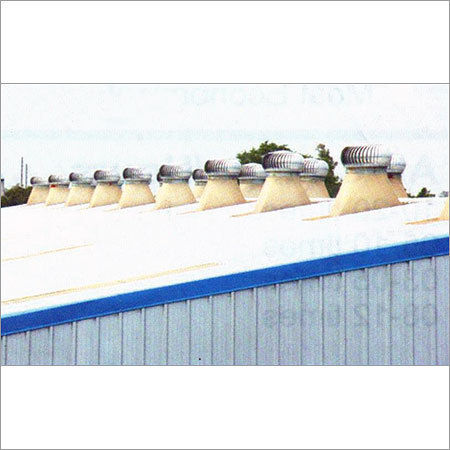Turbine Ventilator
Turbine Ventilator Specification
- Material
- Aluminum
- Type
- Industrial
- Voltage
- 220 Volt (v)
- Installation Type
- Central
- Usage
- Restaurant, Factory, Office, Warehouses
- Function
- Ventilation
Turbine Ventilator Trade Information
- Minimum Order Quantity
- 3 Pieces
- Payment Terms
- Cash in Advance (CID), Cheque, Cash Advance (CA)
- Supply Ability
- 1000 Pieces Per Month
- Delivery Time
- 1 Week
- Sample Available
- Yes
- Sample Policy
- Sample costs shipping and taxes has to be paid by the buyer
- Packaging Details
- Carton Box and Plastic Packing.
- Main Domestic Market
- All India
About Turbine Ventilator
Turbine ventilators have the following salient characteristics and advantages:
1. Totally Wind-Powered: Turbine ventilators run entirely on wind power. A low-pressure region develops inside the ventilator as a result of the vanes or blades rotating as wind travels over the ventilator. The circulation of air is facilitated by this pressure difference, which draws out stale air and draws in new air from the outside.
2. Natural Ventilation: By using the wind's energy to move air, turbine ventilators offer natural ventilation. They can efficiently remove pollutants, odours, hot air, wetness, and moisture from the building, preserving a cosy and healthy indoor atmosphere.
3. Energy Efficiency: Since turbine ventilators run on wind energy, they don't need any fuel or electricity to function. As a result, they are significantly less dependent on mechanical ventilation systems and consume less energy, making them both highly energy-efficient and economical.
4. Turbine ventilators are efficient in eliminating excess heat and moisture from attics, roofs, and other enclosed places. They assist in preventing condensation buildup, which can result in mould growth and structural damage, by continuously exchanging the air.
5. Cost Savings: Over time, turbine ventilators may result in cost savings because they lessen the demand for mechanical ventilation systems and consume less energy. They are a cost-effective ventilation option because of their low maintenance needs and long lifespan.
6. Durability and Weather Resistance: Turbine ventilators are normally made of sturdy materials, such as stainless steel or aluminium, and are made to tolerate severe weather. They are reliable and long-lasting because to their resistance to corrosion, UV rays, and other environmental variables.
7. Simple Installation: Turbine ventilators may be installed onto existing roofs and are very simple to install. They are easier to install and less expensive than some other ventilation systems because they don't need extensive ducting or electrical connections.
When calculating the efficiency of turbine ventilation, it's crucial to take into account variables like wind speed, the quantity and size of turbine ventilators, as well as the design and location of the building. A ventilation expert or engineer can be consulted to determine the precise needs and ideal location for turbine ventilators in a given structure or area.
Features:
- Durability
- Rust resistance
- Robustness
- Smooth functionality
Specification
|
Material |
Aluminium |
|
Automatic Grade |
Automatic |
|
Height |
Upto 19 Inch |
|
Driven Type |
Electric |
|
Air Volume |
3000-8000 m3/h |
|
Speed |
4 m/s |
|
Brand |
SFC |


Price:
- 50
- 100
- 200
- 250
- 500
- 1000+
More Products in Ventilation Equipment Category
Turbine Air Ventilators
Price 3500.00 INR / Piece
Minimum Order Quantity : 5 Pieces
Type : Industrial
Usage : Restaurant, Warehouses, Factory, Office
Installation Type : Central
Material : Aluminum
Roof Turbine Air Ventilator
Price 3500 INR / Piece
Minimum Order Quantity : 5 Pieces
Type : Industrial
Usage : Restaurant, Office, Warehouses, Factory
Installation Type : Central
Material : Aluminum
Wind Ventilator
Price 3500 INR
Minimum Order Quantity : 3 Pieces
Type : Industrial
Usage : Restaurant, Office, Warehouses, Factory
Installation Type : Central
Material : Aluminum
Turbo Roof Air Ventilator
Price 3500 INR
Minimum Order Quantity : 3 Pieces
Type : Industrial
Usage : Restaurant, Office, Warehouses, Factory
Installation Type : Central
Material : Aluminum







